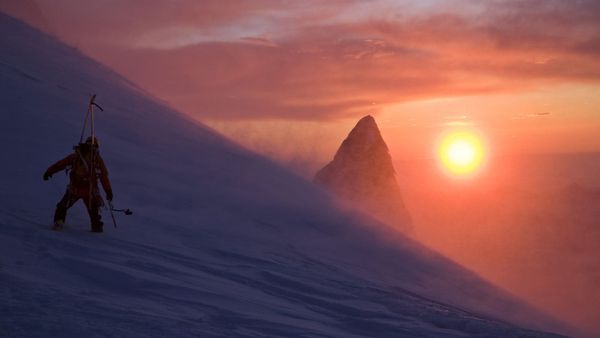 |
| Mountain |
Director Jennifer Peedom has spent a considerable portion of her career telling the stories of mountains. Her 2008 film Miracle On Everest told of the remarkable rescue of Australian climber Lincoln Hall, who almost died atop the world's most famous peak, and in 2015 she captured the tragedy of the Khumbu Icefall avalanche in Sherpa. Now she's back with documentary Mountain, which takes viewers on a tour of some of the world's most spectacular landscapes, set to classical music.
“This one came about because a number of years ago, while I was still making another film, called Sherpa, I was approached by the Australian Chamber Orchestra, who are known for their unusual collaborations and wanted to collaborate on a project about mountains," she explains. “Making a film with an orchestra is not something I’d ever done before and it came with a lot of creative challenges. In many ways that’s the main reason I took it on – I took it on as a creative challenge. The primary outlet for it initially was as a live performance, and what that meant was that you couldn’t have characters, you couldn’t have dialogue, you couldn’t have people chatting, because it needed to work as a live performance. So that agenda was set from the beginning and then when we expanded it out to become a theatrical feature – and there’s also an IMAX movie – it was incredibly challenging because you have to work around the constraints of classical music. You can’t fade out the Beethoven or cut the Vivaldi. That was challenging but also that was what was fun about it. We had to make something that worked as a live experience work as a theatrical film.
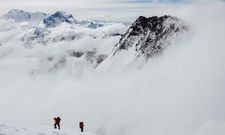 |
| In the foothills |
“We knew very clearly what we wanted to say. We’d brought on board the wonderful writer Robert Macfarlane, whose book Mountains Of The Mind contains many of the lines that work so well in this film, but I’d also spent a lot of time in mountains myself and was thrilled to explore this idea of what draws people to mountains, what makes people risk their lives for the love of this thing that can’t love them back. This was an opportunity to explore those things in a really creative way”
Is she a climber herself?
“I used to be a climber, yeah. Not any more. I have two young children. When I was in my twenties I used to work as a climbing camera operator. I worked on a number of Everest expeditions and on the Himalayan peaks, climbing and always filming at the same time. Making my film Sherpa I developed my relationship with the Sherpa community that became pivotal to that particular film. I think what they experienced helped me understand. I’m not a huge thrill-seeker but I feel that call to nature and I experience that allure of the summit, that incredible feeling that you get when you’re in those places, so I think I may have brought with me some empathy for those climbers and certainly I tried to approach all of that without judgement.
“There are places where this film probably does err on the side of judgement, particularly with the hordes of climbers around Everest, but on the whole I wanted to express some of what those people feel. What does it feel like to be up there and what is the call of the mountains?”
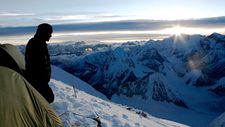 |
| Looking down from base camp |
With so many different locations on display, how did she choose which to include and how to arrange the footage?
“There are a lot of different kinds of mountains in the film. To me it was not about where we were, it was about what we were experiencing... The primary goalpost was did it help to illustrate the story that were trying to tell? And second of all, was it of an absolutely world class visual standard.”
She also wanted to explore the way that human relationships with mountains have evolved over time.
“One of the things that I tried to do in the film and in Robert’s script was show just how quickly even Westerners have gone from fearing and revering mountains – really, it was only 300 years ago that we were terrified and believed that they were the remains of gods and monsters.”
There's an “inherent conflict between the climbers that come to climb these mountains and this minority that lives among them and worship them as deities and gods," she says. "It’s very clear why they need to revere and respect those mountains, because their livelihoods depend on them.”
Then there are the challenges presented by trying to shoot in such environments.
“Being a camera operator is extremely difficult because you have to lug camera gear around and think about filming when you’re just trying to survive.”
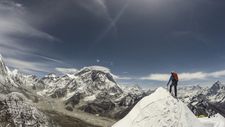 |
| A local climber ascends a peak in Sherpa |
The film would not have been possible without the work of celebrated cinematographer Renan Ozturk.
“He really was a partner in making this film. We drew on many, many hours of footage that he had in his archive that had never been used before. It was really important to have footage from real expeditions that had not been recreated or anything… so it was the obvious thing to do to go straight to some of the best climbers in the world. So in addition to the footage that we shot ourselves, we worked with an amazing production company in Canada called Sherpa Cinema. They have a library of extraordinary footage that they contributed to the film, including the ice tide where it’s sort of like the earth is breathing and the snow is falling on the leaves of the trees and all of those beautiful visual metaphors. Very early on I was aware of their work and really loved it.”
She then cast her net more widely to find footage of base jumping and hang gliding high among the peaks.
“It was a question of seeing where the story was taking us and what do we want to say in this? We drew on people within the community that Renan introduced me to and then we licensed their footage. A lot of that material is GoPro. It relies on the athletes themselves to shoot it.”
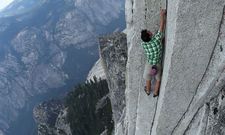 |
| A steep ascent |
Developing the timeline within the film was a complicated business.
“We initially began the film – you know that whole birth to death idea? We initially structured it that way but we decided to move that whole volcanic section. It was once we’d established the whole majesty of the mountains that we needed to introduce the epic scale of time that we’re dealing with here, with mountains and their creation. It’s a hard thing to express visually. Again, that was shot by Sherpa Cinema, all the volcanic stuff.
“Some of the aerial footage was from the Icelandic volcano that happened a couple of years back [the eruption of Eyjafjallajökull]. That wave shot of the Canadian Rockies is also their footage. The intention was to explore in a creative, poetic way, remembering that this could never be a traditional documentary because of the way it began and the live performance element. It was always about finding visual metaphors.”
How did she get Willem Dafoe to provide the film's narration?
“Renan was actually the narrator for quite a long time but he grudgingly agreed that we should probably find somebody else.” She laughs affectionately. “It took me a long time to really land on the right person. One thing that was important to me was that I had to be able to imagine that person on a mountain, and also that the person would relate to the creative intention of the project. Willem had been in an Australian film shot in the mountains in Tasmania, so for that reason I could visualise him in mountains. And I also had this real sense of him as an artist and a risk taker, and that was obviously something that was important to the film. I just kind of had a hunch that maybe he would get it.
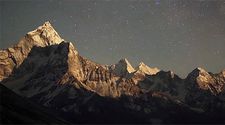 |
| Under the stars |
“He and his manager apparently have a criterion where they look at things and if they can understand why they’re asking for him and not just anybody else then that was their criterion, and evidently in this process they saw that straight away. He said ‘Yes’ and ‘Where and when?’ We shot together in Rome, actually, where he’s part time based, and it was fantastic. He really got it, he appreciated it, he loved what we were trying to achieve. He’s just been wonderful in every way. He came out to the Sydney Opera House where the world première happened with the Chamber Orchestra performing live… it was a hunch and we were lucky.”
Next up for Jennifer is a drama about Tenzing Norgay, the first Sherpa to climb Everest. Mountains are in her blood.





















